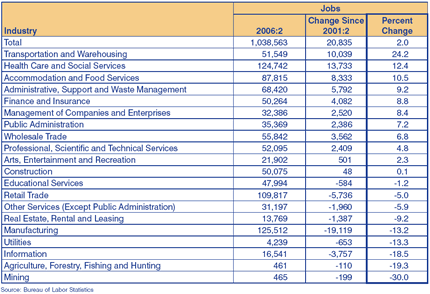The Cincinnati-Middletown-Wilmington CSA
This article is the sixth of seven highlighting each of Indiana's combined statistical areas (CSAs). CSAs are groupings of predefined metropolitan (metro) and/or micropolitan (micro) areas that, as the title suggests, combine these areas to “represent larger regions and reflect broader social and economic interactions.” (1)
The Area
There are 16 counties included in the Cincinnati-Middletown-Wilmington CSA, only three of which are within the Indiana state lines—Dearborn, Franklin and Ohio counties. Six are in neighboring Ohio: Brown, Butler, Clermont, Clinton, Hamilton and Warren counties. The remaining seven are in Kentucky: Boone, Bracken, Campbell, Gallatin, Grant, Kenton and Pendleton (see Figure 1). Ranking 18th in population among the 121 CSAs in the United States, its 2.1 million residents made up 0.7 percent of the U.S. population in 2005. The Ohio counties make up the majority of the population for this CSA (77.2 percent) while the Indiana counties make up the least (3.7 percent).
Figure 1: Cincinnati-Middletown-Wilmington CSA
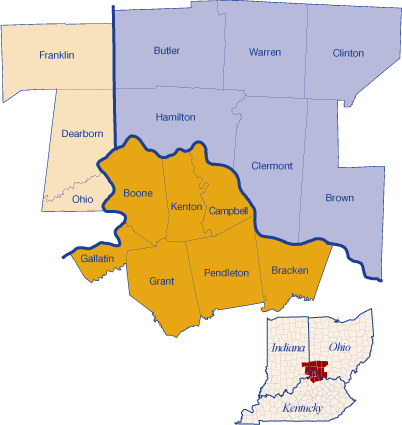
Since 2000, the Cincinnati-Middletown-Wilmington CSA has increased in population by more than 57,800 residents (2.8 percent growth). Ohio's portion of the CSA grew the fastest (53.3 percent) followed by Kentucky's portion (40.1 percent). Only two counties in the CSA lost population over that time, including Hamilton County, Ohio (lost 37,322 people) and Campbell County, Kentucky (lost 1,396 people). While Indiana's population is a small fraction of the CSA, all three counties were able to maintain growth from 2000 to 2005.
Jobs
Jobs in the Cincinnati-Middletown-Wilmington CSA have risen since 2001, increasing 2 percent over the five-year span. As far as change in total jobs are concerned, the CSA is performing better than Indiana and Ohio overall, but not as well as Kentucky (see Figure 2). Three industries each made up 10 percent of the job share in 2006, including manufacturing, retail trade and health care and social services. These three industries are also highlighted in Figure 2.
Figure 2: Percent Change in Jobs in the CSA and Respective States, 2001:2 to 2006:2
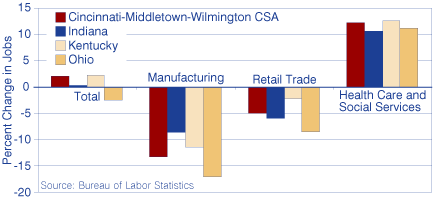
Coinciding with the relative population sizes, jobs in these three industries are dispersed quite unevenly among the three states that make up the Cincinnati-Middletown-Wilmington CSA. Ohio contributes at least three quarters of the jobs in each of the three industries while the Indiana counties make up less than 3 percent of jobs in these industries (see Figure 3).
Figure 3: Jobs in Heavily-Concentrated Industries in the Cincinnati-Middletown-Wilmington CSA, 2006:2
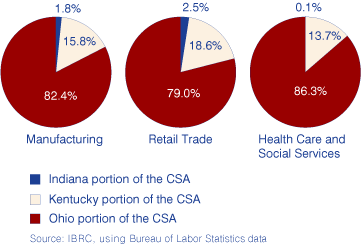
Stepping back outside the focus of the three major industry sectors in the area, transportation and warehousing has seen an impressive increase in its share of total jobs since 2001, making up 5 percent of jobs in the area in 2006 (up from 4.1 percent in 2001). This increase is a result of adding more than 10,000 jobs while many of the other industries lost jobs (see Table 1). Only health care and social services increased its share by more, making up 10.9 percent and 12.0 percent of jobs in 2001 and 2006, respectively.
Table 1: Change in Jobs in the Cincinnati-Middletown-Wilmington CSA, 2001:2 to 2006:2
Wages
It appears as though the CSA is a stronghold for each of the three states in terms of average weekly wages paid across all industries. Figure 4 shows that average weekly wages in the CSA were at $764 in 2006:2, higher than Indiana, Kentucky and Ohio by $80, $92 and $48 per week, respectively. The good news for the CSA and each of the three states of which it is a part, is that average weekly wages have been climbing since 2001, with the CSA seeing an impressive $108 increase in the past five years.
Figure 4: Average Weekly Wages, 2006:2
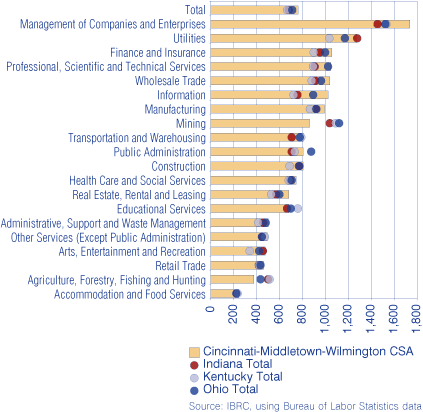
There were six industries averaging more than $1,000 in weekly wages in the Cincinnati-Middletown-Wilmington CSA in 2006. These included management of companies and enterprises ($1,736), utilities ($1,274), finance and insurance ($1,058), professional, scientific and technical services ($1,047), wholesale trade (1,038), and information ($1,024). At the other end of the spectrum, five industries paid less than $500 per week on average to their employees, including the large retail trade industry.
Mining was the only major industry sector to experience a decrease in wages from 2001 to 2006, with workers being paid $56 less per week on average in 2006, without adjusting for inflation. This only holds true for the CSA, as Indiana, Kentucky and Ohio each increased wages across all industries.
Commuting
There were about 986,000 workers living in the Cincinnati-Middletown-Wilmington CSA according to Census 2000 data. Of those, only 61.4 percent lived and worked in the same county and another 34 percent traveled to one of the 15 other counties within the combined statistical area. There were 52,300 people living outside the CSA and commuting into the area for work. Meanwhile, about 45,500 workers left the CSA to work elsewhere (see Figure 5).
Figure 5: Commuting Patterns in the Cincinnati-Middletown-Wilmington CSA, 2000
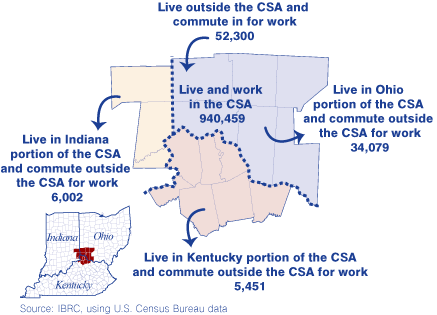
Notes
- U.S. Office of Management and Budget, available at www.whitehouse.gov/omb/.
Molly Manns, Associate Editor
Indiana Business Research Center, Kelley School of Business, Indiana University

